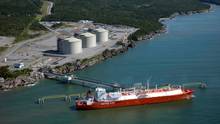In race to export LNG, a new Atlantic plan.
 The vision to export natural gas from Canada is taking a sharp turn to the east.
The vision to export natural gas from Canada is taking a sharp turn to the east.Alfred Sorensen, president of Pieridae Energy Canada, has a dream to build a major liquefied natural gas export facility on Canada’s East Coast, the first of its kind. The $5-billion (U.S.) project is an eastern addition to a race unfolding in Western Canada to build LNG infrastructure that would allow major exports from the coast of British Columbia to global markets.
The former Duke Energy Corp. executive says the timing and conditions are right for construction of a complex in Goldboro, N.S. that would liquefy natural gas and ship it to markets in Europe and India. The site would have on-site storage capacity of 420,000 cubic metres.
But the plan must overcome some major challenges if it is to become reality. One is whether Pieridae can successfully lock in a sufficient number of long-term contracts to justify the project’s high price tag. Another is growing pressure for cheaper prices from overseas buyers.
A planned LNG export facility on the east coast is another element in the rapidly shifting energy flows of North America.
The project would tap into existing pipeline infrastructure in the east, possibly requiring the reversal of some routes that currently bring U.S. gas to domestic markets to instead take it to the east coast for export abroad. And the plan comes amid other efforts to bring Western Canadian oil eastward, as refiners seek to take advantage of abundant supplies.
Mr. Sorensen, who spearheaded the Kitimat LNG project in British Columbia before selling it two years ago to Apache Corp. and EOG Resources for about $300-million (Canadian), says he’s confident he can make Goldboro work.
“We looked into possible other opportunities for LNG besides Kitimat and, after several important discussions with long-term users, we decided there is sufficient demand” for an East Coast LNG terminal, he said in a telephone interview Wednesday.
Europe and India are targeted as the two main export markets for the planned five million tonnes a year of LNG. Europe and India “are two areas where we have either executed or are very close to executing MOUs [memorandums of understanding] with long-term buyers of natural gas,” Mr. Sorensen said.
But Europe is not an easy market to crack because it’s highly competitive given the availability of low-cost natural gas from Russia as well as the North Sea gas play, said Peter Tertzakian, chief energy economist and managing director at Calgary-based ARC Financial Corp.
Mr. Sorensen says the potential customers in Europe he has spoken to are looking to diversify their supply, and natural gas from Canada fits the bill.
Another issue facing Mr. Sorensen’s company is the strong push from buyers around the globe to abandon the standard practice of using natural gas contracts linked to the price of oil, which make for higher gas prices. Europe, in particular, is seeing a declining number of oil-linked contracts.
Then there is the question of supply. Sourcing enough natural gas from Canadian producers on the East Coast may prove difficult because of lack of availability, Mr. Tertzakian said. If most of the supply were to come from the massive Marcellus shale in Pennsylvania, then the Goldboro LNG terminal would just act as a transit facility for U.S. producers.
“We’re looking first at a Canadian solution, both onshore and offshore,” Mr. Sorensen said. Potential reserves might eventually be available from the promising Quebec shale gas play, but the province has imposed a moratorium on development pending the conclusion of lengthy environmental studies, and low North American gas prices currently make it uneconomic to develop.
“A Goldboro LNG export terminal will greatly contribute to our world-class oil and gas sector and position Nova Scotia as a strategic energy exporter,” Nova Scotia Premier Darrell Dexter said.
You can return to the main Market News page, or press the Back button on your browser.

